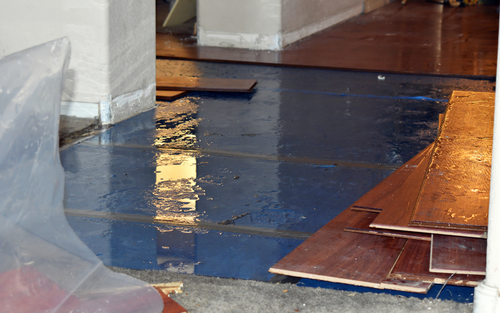Avoid Respiratory Hazards of Flood Clean-up
Rising sea levels caused by climate change and powerful storms have made flooding a common occurrence across the U.S., most recently impacting several parts of California. Businesses and private residences can easily be flooded with water when it has nowhere else to go. But flooding leads to the spread of harmful mold, dust, fungi, bacteria, viruses, and parasites, especially ininstances where sewers can overflow. Workers will need to wear the proper personal protective equipment (PPE) to avoid respiratory and other hazards during the flood clean-up process, including respirators, facemasks and even gloves and footwear to limit the spread of bacteria.
Know the Risks
High water levels can lead to a variety of hazards in indoor and outdoor environments. Many of these hazards can lead to respiratory issues and long-term health complications. Workers occupying confined spaces, such as basements and crawl spaces, face an even greater risk of breathing in these hazards due to poor ventilation.
Mold poses the widest area of risk in flood clean-up zones. It can grow on a variety of building surfaces both indoors and out. It is commonly found on plaster walls, furniture, carpet, paneling and inside ceiling tiles. Surfaces that have been wet for at least 48 hours are likely to grow mold within a short period of time. If the material is absorbent, such as wood, paper or cloth, it will likely need to be thrown out. Hard surfaces, such as steel and plastic can be cleaned more easily and may be salvageable.
The destruction caused by a flood can also release dust containing hazardous particles into the air, including lead, asbestos and silica dust. Asbestos is commonly found in insulation materials, ceiling tiles, walls and paneling. Lead typically is found in many homes built before 1978. Silica dust can be found in pulverized sand, stone, concrete, and mortar.
Floodwater can also contain biohazards that can be dangerous if inhaled or swallowed, including E. coli, salmonella, shigella, and hepatitis A virus. Workers should keep their distance from water that is not moving, and use caution when coming into contact with flood water. Everyone working in the area should wash their hands with soap and water regularly to resist the spread of germs.
Wear the Proper PPE
Workers will need to choose PPE and safety items based on the hazards identified in the space. If mold is present in the environment, everyone will need to wear a respirator to avoid breathing in airborne particles. If the space is less than 100 square feet, a NIOSH-approved N95 respirator will suffice. Workers can also wear N100 facemasks or respirators for additional protection. They will also need to wear hazmat suits, such as disposable coveralls, headgear, disposable gloves and covers on their shoes to avoid tracking the mold around. Rubber boots are also an option if they can be properly cleaned and sanitized after.
If the space is larger than 100 square feet, a professional mold remediation crew should be contacted to resolve the situation. Anyone working in the space will need to wear a full-face N100 respirator, which will filter out 100% of the hazardous particles in the air. Some instances may require a powered air-purifying respirator (PAPR) system that filters and cleans hazardous ambient air before delivering it to the worker wearing it. Everyone will also need disposable coveralls, gloves, head coverings and foot protection.
If there are other respiratory hazards in the space, workers should make sure their gear is designed to protect against these threats as well.
Everyone should inspect their PPE before wearing them in the field. The respirator or facemask should fit properly over the person’s face without leaving any gaps. There shouldn’t be any holes, rips, or tears in the disposable workwear to keep toxic particles at bay.
Create a Respiratory Protection Program
Every business or clean-up crew must have a documented respiratory protection program in place that meets the requirements of the 29 CFR 1910.134 before assigning workers to affected areas. Everyone going into the space must have access to the proper PPE, and enough time to inspect their equipment thoroughly before the start of their shift. There should be extra PPE on the premises in case any get damaged in the field.
The organization must also train its employees to use this equipment effectively, and inform them of the dangers of working in flood clean-up zones. Every precaution should be taken to protect the crew from exposure to these hazards. Sanitation stations may be needed to help workers wash their hands throughout the day.
The group may also need to adjust its safety response plan over time as the hazards change. Unfortunately, homes and businesses are more prone to flooding during extreme weather. If a person or organization doesn’t have the proper gear or experience cleaning up the aftermath of a flood, they should contact a professional clean-up crew. Individuals shouldn’t have to put their health at risk in the aftermath of a major storm. If you’re looking for flood clean-up PPE or other safety equipment and supplies, contact PK Safety today.
Recent Posts
-
Customizing Gas Detectors: Tailoring Solutions to Fit Your Unique Requirements
In today’s diverse industrial landscape, a one-size-fits-all approach to safety simply doesn’t cu …Jul 3rd 2024 -
10 Ways to Prevent Wildfires
You can prevent wildfires by extinguishing flames before you leave the worksite. Avoid practicing …Jul 1st 2024 -
ANSI/ISEA 138 Safety Gloves: Ensuring Hand Protection
The human hand is an anatomical masterpiece and arguably the greatest tool attached to our bodies …Jun 25th 2024





